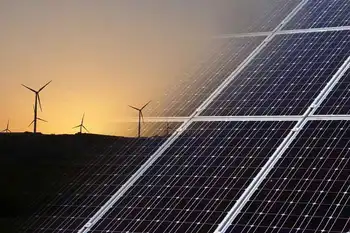Ukraine's Green Fightback: Rising from the Ashes with Renewable Energy

High Voltage Maintenance Training Online
Our customized live online or in‑person group training can be delivered to your staff at your location.

- Live Online
- 12 hours Instructor-led
- Group Training Available
Ukraine Green Fightback advances renewable energy, energy independence, and EU integration, rebuilding war-damaged grids with solar, wind, and storage, exporting power to Europe, and scaling community microgrids for resilient, low-carbon recovery and REPowerEU alignment.
Key Points
Ukraine Green Fightback shifts to renewables and resilient grids, aiming 50% clean power by 2035 despite wartime damage.
✅ 50% renewable electricity target by 2035, up from 15% in 2021
✅ Community solar and microgrids secure hospitals and schools
✅ Wind and solar rebuild capacity; surplus exports to EU grids
Two years after severing ties with Russia's power grid, Ukraine stands defiant, rebuilding its energy infrastructure with a resolute focus on renewables. Amidst the ongoing war's devastation, a remarkable green fightback is taking shape, driven by a vision of a self-sufficient, climate-conscious future.
Energy Independence, Forged in Conflict:
Ukraine's decision to unplug from Russia's grid in 2022 was both a strategic move and a forced necessity, aligning with a wider pushback from Russian oil and gas across the continent. While it solidified energy independence aspirations, the full-scale invasion pushed the country into "island mode," highlighting vulnerabilities of centralized infrastructure.
Today, Ukraine remains deeply intertwined with Europe, inching towards EU accession and receiving global support, as Europe's green surge in clean energy gathers pace. This aligns perfectly with the country's commitment to environmental responsibility, further bolstered by the EU's own "REPowerEU" plan to ditch fossil fuels.
Rebuilding with Renewables:
The war's impact on energy infrastructure has been significant, with nearly half damaged or destroyed. Large-scale renewables have borne the brunt, with 30% of solar and 90% of wind farms facing disruption.
Yet, the spirit of resilience prevails. Surplus electricity generated by solar plants is exported to Poland, showcasing the potential of renewable sources and mirroring Germany's solar power boost across the region. Ambitious projects are underway, like the Tyligulska wind farm, Ukraine's first built in a conflict zone, already supplying clean energy to thousands.
The government's vision is bold: 50% renewable energy share by 2035, a significant leap from 2021's 15%, and informed by the fact that over 30% of global electricity already comes from renewables. This ambition is echoed by civil society groups who urge even higher targets, with calls for 100% renewable energy worldwide continuing to grow.
Community-Driven Green Initiatives:
Beyond large-scale projects, community-driven efforts are flourishing. Villages like Horenka and Irpin, scarred by the war, are rebuilding hospitals and schools with solar panels, ensuring energy security and educational continuity.
These "bright examples," as Svitlana Romanko, founder of Razom We Stand, calls them, pave the way for a broader green wave. Research suggests replacing all coal plants with renewables would cost a manageable $17 billion, paving the way for a future free from dependence on fossil fuels, with calls for a fossil fuel lockdown gaining traction.
Environmental Cost of War:
The war's ecological footprint is immense, with damages exceeding €56.7 billion. The Ministry of Environmental Protection and Natural Resources is meticulously documenting this damage, not just for accountability but for post-war restoration.
Their efforts extend beyond documentation. Ukraine's "EcoZagroza" app allows citizens to report environmental damage and monitor pollution levels, fostering a collaborative approach to environmental protection.
Striving for a Greener Future:
President Zelenskyy's peace plan highlights ecocide prevention and environmental restoration. The ministry itself is undergoing a digitalization push, tackling corruption and implementing EU-aligned reforms.
While the European Commission's recent progress report acknowledges Ukraine's strides, set against a Europe where renewable power has surpassed fossil fuels for the first time, the "crazy rhythm" of change, as Ecoaction's Anna Ackermann describes it, reflects the urgency of the situation. Finding the right balance between war efforts and green initiatives remains a crucial challenge.
Conclusion:
Ukraine's green fightback is a testament to its unwavering spirit. Amidst the darkness of war, hope shines through in the form of renewable energy projects and community-driven initiatives. By embracing a green future, Ukraine not only rebuilds but sets an example for the world, demonstrating that even in the face of adversity, sustainability can prevail.











